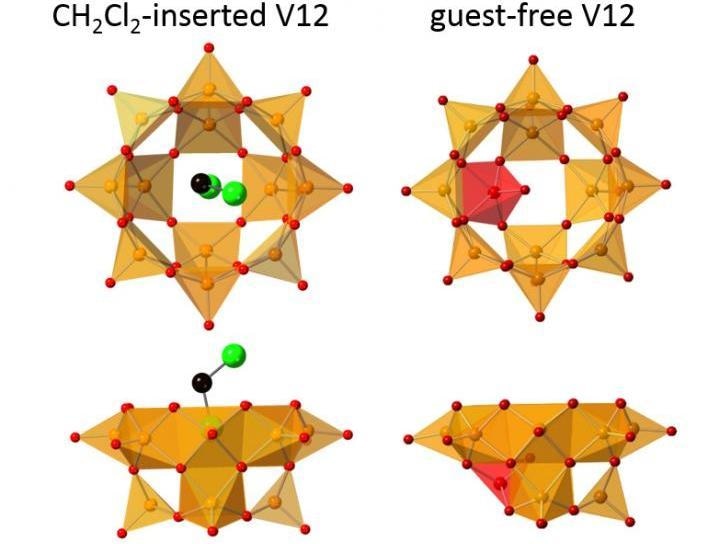Jan 8 2019
How can carbon dioxide be separated from carbon monoxide? As demonstrated in a new study from Kanazawa University, one way is to use a bowl of vanadium. To be more precise, a hollow, spherical cluster of vanadate molecules can distinguish between CO2 and CO, enabling potential uses in CO2 capture and storage.
 Anion structures of CH2Cl2(guest)-inserted V12 (left) and guest-free V12 are shown. Orange and red square pyramids represent VO5 units with their bases directed to the center of the bowl, and the inverted VO5 unit. Green and black spheres represent Cl and C, respectively. Hydrogen atoms of CH2Cl2 are omitted for clarity. (Image credit: Kanazawa University)
Anion structures of CH2Cl2(guest)-inserted V12 (left) and guest-free V12 are shown. Orange and red square pyramids represent VO5 units with their bases directed to the center of the bowl, and the inverted VO5 unit. Green and black spheres represent Cl and C, respectively. Hydrogen atoms of CH2Cl2 are omitted for clarity. (Image credit: Kanazawa University)
At the molecular level, small objects can fit into bigger ones, quite similar to what happens in the everyday world. The ensuing arrangements, called the host-guest interactions, are made stable by non-covalent forces such as hydrogen bonds and electrostatics. Based on the size of its entrance and the amount of interior space it can provide the guest, each host will contentedly let in some molecules while obstructing others.
V12 is one such host. It has a rough sphere composed of 12 atoms of the transition metal vanadium, linked through 32 oxygen atoms. At one end of the bowl-like structure, there is a 0.44 nm wide opening, ideal for permitting the right molecule to nestle inside the cavity.
V12 accepts a range of guests on the scale of small organic compounds. In fact, it’s rather hard to isolate an empty V12 by itself. While the host stabilizes its guest, so the guest returns the favor—if we remove the guest, the host quickly replaces it with another molecule.
Yuji Kikukawa, Study Co-Corresponding Author, Kanazawa University
The study has been published in the Angewandte Chemie journal.
In V12, each vanadium atom forms a square-pyramid with five oxygen atoms. The oxygen atoms of each VO5 face outwards, while the inner cavity is filled by the positive charge from vanadium, enabling electron-rich (or anionic) guests to be stable. However, for the first time, the Kanazawa researchers developed a guest-free V12 by using a solvent (acetone) whose molecules are too large to fit inside the opening.
In order to compensate for the missing guest, the empty V12 bowl did something surprising. Similar to an umbrella inverting in heavy wind, the VO5 unit at the bottom flipped inwards. Consequently, the negative terminal oxygen of the single “upside-down” VO5 filled the host cavity. Researchers have never before spotted this atomic shifting to hold a new structure—known as a polytopal rearrangement—in metal oxide clusters. Infrared spectroscopy could be used to monitor the transformation of the structure.
“We then took the empty V12 and explored which guests we could insert back into the bowl,” the authors state. “Nitrogen, methane, and carbon monoxide were all rejected, but carbon dioxide was readily taken up. This immediately suggests a way to separate CO2 from other gases.”
As a matter of fact, V12 and CO2 exhibited such an ideal fit that CO2 could be put in even at low atmospheric pressure. Hence, V12 might be an appropriate solution in CO2 capture to tackle climate change, and even in CO2 storage for the developing technology of artificial photosynthesis.